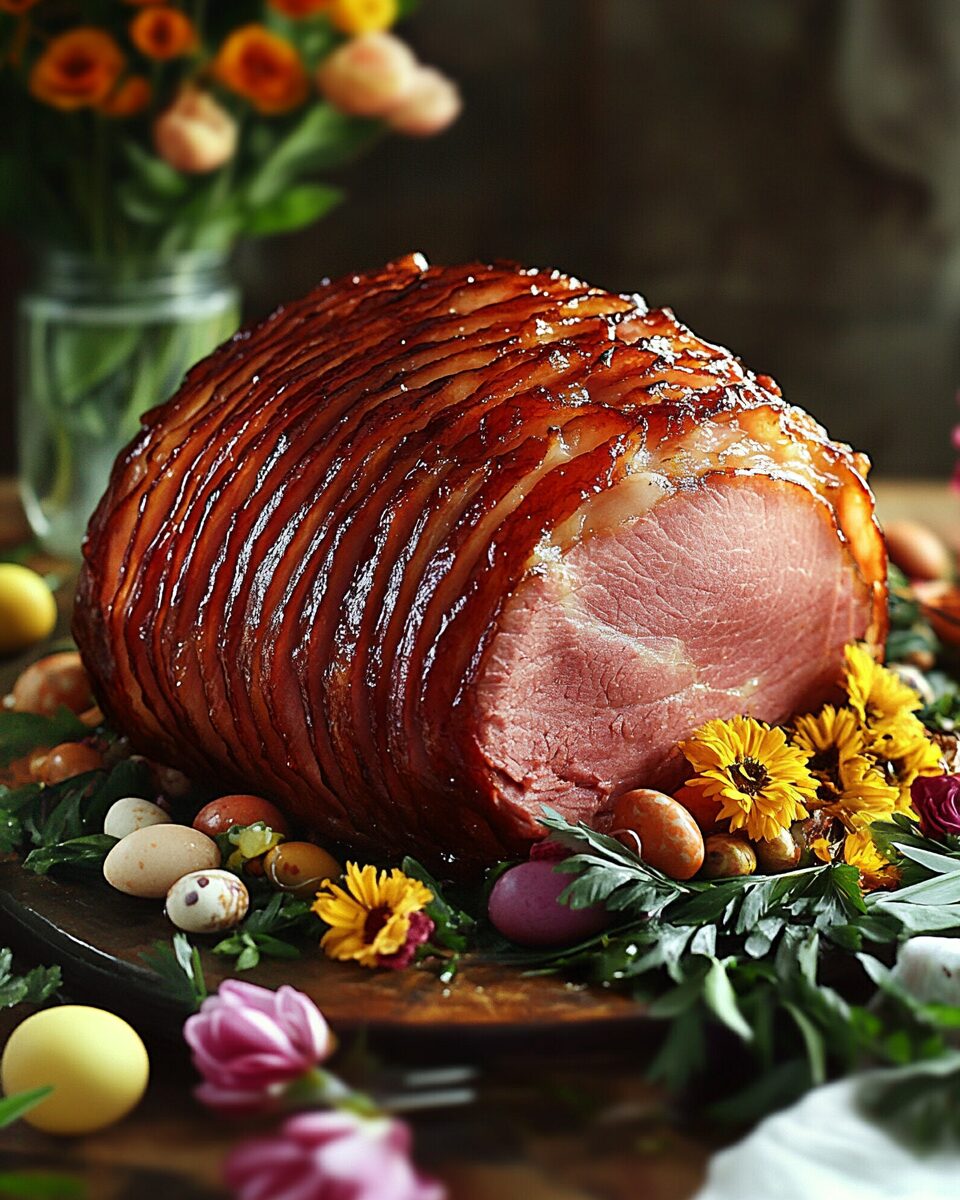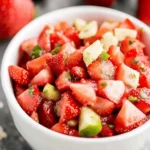This delightful Glazed Easter Ham combines the rich flavors of a tender ham with a sweet and tangy glaze, making it a perfect centerpiece for your holiday meal. The combination of maple syrup, spiced rum, and molasses creates a luscious coating that enhances the natural taste of the ham.
FULL RECIPE:
Ingredients
For the ham:
- 2 kg rolled ham joint (smoked or unsmoked)
- 500 ml alcoholic ginger beer
- 750 ml non-alcoholic ginger beer
- 1 onion, quartered
- 2 bay leaves
- 4 garlic cloves, lightly crushed
- 1 tsp black peppercorns, lightly crushed
- 1 tsp allspice berries, lightly crushed
For the glaze:
- 90 ml maple syrup
- 60 ml poaching liquor (from the pot)
- 50 ml spiced rum
- 2 tbsp wholegrain mustard
- 3 tbsp molasses
Directions
-
Poach the ham: Place the ham in a deep pot and add the alcoholic and non-alcoholic ginger beer, onion, bay leaves, garlic, black peppercorns, and allspice berries. Add cold water to cover the ham completely. Cover the pot with a lid and simmer gently for 2 hours.
-
Prepare the glaze: While the ham is poaching, combine the maple syrup, 60 ml of the poaching liquor, spiced rum, wholegrain mustard, and molasses in a separate pot. Bring the mixture to a rolling boil over high heat for 5 minutes, then reduce the heat and let it boil gently for an additional 20 minutes until it thickens. Remove from heat and set aside.
-
Preheat the oven: Set your oven to 170°C (fan)/gas mark 5.
-
Prepare the ham for glazing: Once the ham has finished poaching, remove it from the pot and let it cool slightly. Carefully peel off the rind, leaving the fat intact. Score the fat in a criss-cross pattern and stud the ham with whole cloves, spacing them about 2-3 inches apart.
-
Apply the glaze and bake: Place the ham in a baking dish and pour the prepared glaze over it. Sprinkle brown sugar on top and gently press it into the clove-studded fat. Bake the ham in the preheated oven for 15 minutes.
-
Baste and continue baking: Remove the ham from the oven and spoon the glaze from the baking dish back over the ham. Return it to the oven and bake for another 15 minutes. Repeat this basting process 2-3 more times until the ham is beautifully glazed and heated through.
-
Serve: Let the ham rest for a few minutes before slicing. Serve warm, accompanied by sliced grilled pineapple if desired.
Nutrients
- Serving Size: Approximately 200 g
- Calories: 450 kcal
- Protein: 30 g
- Carbohydrates: 25 g
- Sugars: 20 g
- Fat: 22 g
- Saturated Fat: 8 g
- Cholesterol: 80 mg
- Sodium: 1500 mg
- Potassium: 600 mg
- Fiber: 0 g
- Vitamin A: 2% DV
- Vitamin C: 4% DV
- Calcium: 4% DV
- Iron: 10% DV
The Tradition of Easter Ham
Easter ham is a classic dish that has been a centerpiece for holiday gatherings for centuries. The tradition dates back to ancient Europe, where early civilizations would cure and preserve pork over the winter months. Since fresh meat was not readily available in early spring, ham became a natural choice for Easter feasts. Over time, different cultures developed their own methods of preparing and seasoning ham, with glazes becoming a popular way to enhance its flavor. The sweet and savory combination of glazed ham offers a perfect balance that appeals to a wide range of palates. While some families prefer a classic honey glaze, others opt for ingredients like maple syrup, brown sugar, mustard, or even fruit-based glazes.
The Appeal of Glazed Ham
One of the reasons glazed ham remains a staple of Easter and other holiday celebrations is its ability to feed a large group while remaining easy to prepare. Unlike other main dishes that require extensive attention, a ham only needs occasional basting, allowing the cook to focus on side dishes and entertaining guests. The versatility of this dish also makes it a favorite. Whether served warm as the main course or enjoyed as leftovers in sandwiches, omelets, or casseroles, a well-prepared ham remains delicious even after the holiday meal is over. The caramelized glaze not only adds flavor but also gives the ham a beautiful golden-brown color that enhances its presentation.
Choosing the Right Ham
Selecting the right ham is crucial for achieving the best results. There are several types of ham available in the market, each with distinct characteristics:
- Smoked vs. Unsmoked: Smoked ham has a deeper, richer flavor due to the curing process, while unsmoked ham offers a milder, more natural taste.
- Bone-in vs. Boneless: Bone-in ham tends to be juicier and more flavorful, while boneless ham is easier to carve.
- Cured vs. Fresh: Most hams sold in stores are cured or pre-cooked, making them more convenient. Fresh ham requires longer cooking times but allows for greater control over seasoning.
The Secret to a Perfect Glaze
The glaze is what sets this Easter ham apart, adding layers of sweetness, spice, and depth. The combination of maple syrup, molasses, and spiced rum creates a glaze that is both rich and aromatic.
- Molasses contributes a deep, slightly bitter sweetness that enhances the ham’s natural flavors.
- Maple syrup adds a smooth, caramel-like sweetness that blends well with the salty notes of the ham.
- Spiced rum introduces a warm, slightly smoky undertone that elevates the overall taste.
- Wholegrain mustard adds a hint of tanginess, helping balance the sweetness of the glaze.
- Brown sugar caramelizes beautifully when baked, creating the signature sticky coating.
Pairing Glazed Ham with Side Dishes
A well-rounded Easter meal includes side dishes that complement the ham’s sweet and savory profile. Here are some popular accompaniments:
- Roasted Vegetables: Carrots, Brussels sprouts, and asparagus roasted with olive oil and herbs make a great pairing.
- Scalloped Potatoes: Creamy and cheesy potatoes provide a comforting contrast to the ham’s sweetness.
- Glazed Pineapple Slices: Adding grilled or caramelized pineapple enhances the fruity undertones of the glaze.
- Fresh Salad: A crisp green salad with citrus dressing helps balance the richness of the ham.
- Dinner Rolls: Soft, buttery rolls are perfect for soaking up the delicious glaze.
Storage and Leftover Ideas
One of the best things about a glazed ham is the abundance of leftovers. Properly stored, leftover ham can be enjoyed in various ways over the next several days.
Storage Tips:
Advertisement
- Store leftover ham in an airtight container in the refrigerator for up to 5 days.
- For longer storage, slice the ham and freeze it in portions, ensuring it’s wrapped tightly to prevent freezer burn.
- Keep any leftover glaze or pan juices to drizzle over reheated slices for extra moisture.
Creative Ways to Use Leftovers:
- Ham and Cheese Omelet: Dice the ham and add it to scrambled eggs with melted cheese.
- Ham and Potato Soup: Use the ham bone to create a flavorful broth for a hearty soup.
- Ham and Swiss Sandwich: Serve with Dijon mustard on crusty bread for a quick and tasty meal.
- Ham and Pineapple Pizza: Add ham and pineapple to a homemade or store-bought pizza base for a sweet and savory combination.
- Ham and Pasta Bake: Mix chopped ham with pasta, cheese, and a creamy sauce for a comforting casserole.
Conclusion
Glazed Easter Ham is more than just a meal—it’s a cherished tradition that brings families together around the dinner table. The combination of a beautifully caramelized glaze and tender, juicy ham creates a dish that is both impressive and easy to prepare. Whether served as the highlight of an Easter feast or enjoyed in creative leftover recipes, this dish remains a timeless favorite. This recipe not only honors the history of Easter ham but also adds a unique and flavorful twist that will have guests coming back for more.






